Comparative Analysis of Quality Theories and Models in Healthcare
VerifiedAdded on 2020/01/07
|12
|4126
|223
Report
AI Summary
This report delves into the application of various quality theories and models within the healthcare sector, with a specific focus on West Middlesex University Hospital. It begins by defining key terminologies such as Total Quality Management (TQM), the healthcare sector, patient satisfaction, and the SERVQUAL model. The report then provides an overview of the characteristics of the healthcare sector, including the role of the NHS, funding mechanisms, and the services provided by hospitals. It analyzes the strengths and differences between quality theories and models, particularly the SERVQUAL model, which is used to assess patient perceptions of service quality, and the EFQM framework, which focuses on nine quality control criteria. The report also examines the SERVPERF model and other quality transformation efforts. The analysis highlights the importance of patient satisfaction, continuous improvement, and the integration of quality management practices to enhance the overall performance of healthcare organizations. The report uses current statistics and research to support its findings, providing a comprehensive understanding of quality management in healthcare.
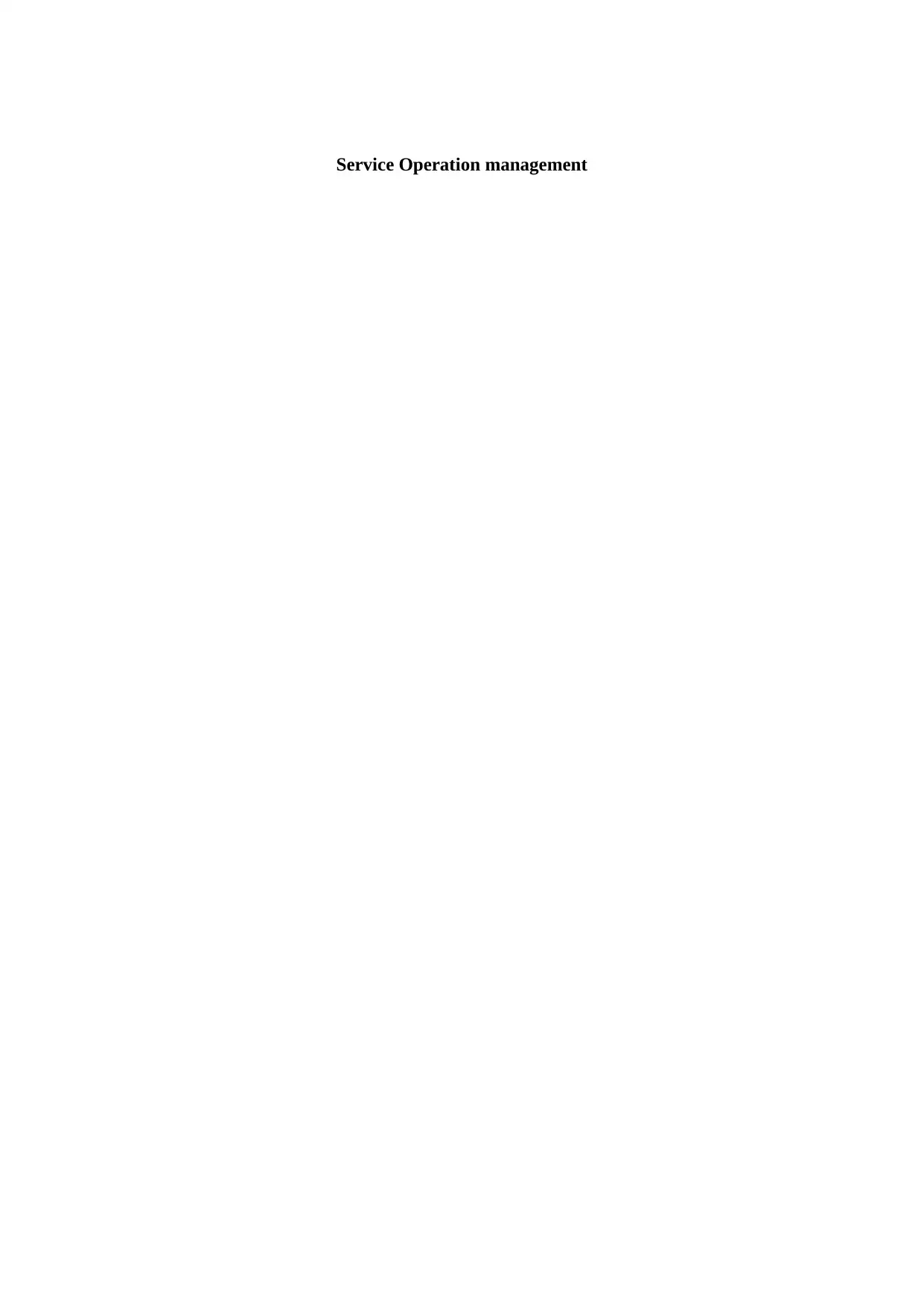
Service Operation management
Paraphrase This Document
Need a fresh take? Get an instant paraphrase of this document with our AI Paraphraser
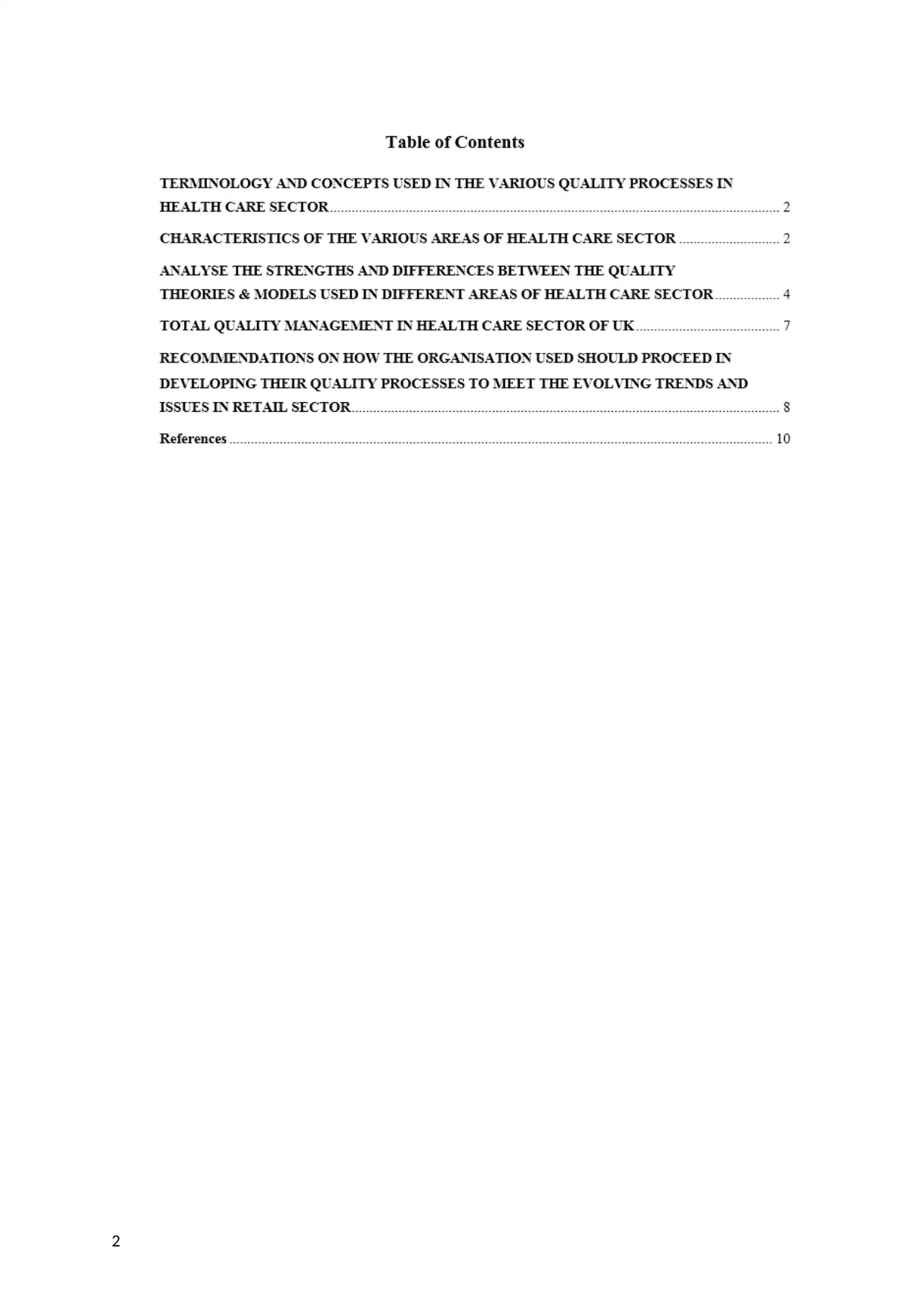
2
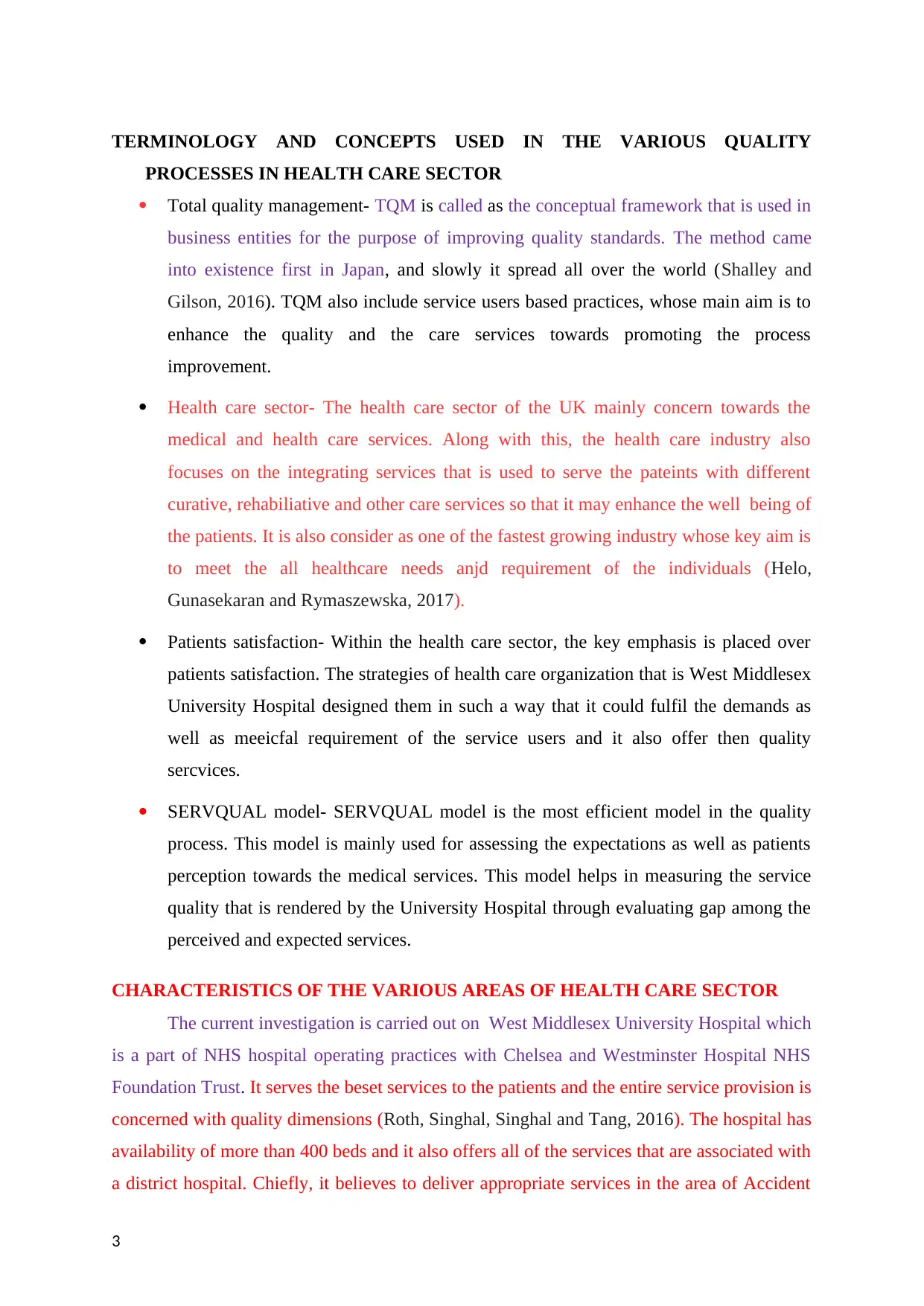
TERMINOLOGY AND CONCEPTS USED IN THE VARIOUS QUALITY
PROCESSES IN HEALTH CARE SECTOR
Total quality management- TQM is called as the conceptual framework that is used in
business entities for the purpose of improving quality standards. The method came
into existence first in Japan, and slowly it spread all over the world (Shalley and
Gilson, 2016). TQM also include service users based practices, whose main aim is to
enhance the quality and the care services towards promoting the process
improvement.
Health care sector- The health care sector of the UK mainly concern towards the
medical and health care services. Along with this, the health care industry also
focuses on the integrating services that is used to serve the pateints with different
curative, rehabiliative and other care services so that it may enhance the well being of
the patients. It is also consider as one of the fastest growing industry whose key aim is
to meet the all healthcare needs anjd requirement of the individuals (Helo,
Gunasekaran and Rymaszewska, 2017).
Patients satisfaction- Within the health care sector, the key emphasis is placed over
patients satisfaction. The strategies of health care organization that is West Middlesex
University Hospital designed them in such a way that it could fulfil the demands as
well as meeicfal requirement of the service users and it also offer then quality
sercvices.
SERVQUAL model- SERVQUAL model is the most efficient model in the quality
process. This model is mainly used for assessing the expectations as well as patients
perception towards the medical services. This model helps in measuring the service
quality that is rendered by the University Hospital through evaluating gap among the
perceived and expected services.
CHARACTERISTICS OF THE VARIOUS AREAS OF HEALTH CARE SECTOR
The current investigation is carried out on West Middlesex University Hospital which
is a part of NHS hospital operating practices with Chelsea and Westminster Hospital NHS
Foundation Trust. It serves the beset services to the patients and the entire service provision is
concerned with quality dimensions (Roth, Singhal, Singhal and Tang, 2016). The hospital has
availability of more than 400 beds and it also offers all of the services that are associated with
a district hospital. Chiefly, it believes to deliver appropriate services in the area of Accident
3
PROCESSES IN HEALTH CARE SECTOR
Total quality management- TQM is called as the conceptual framework that is used in
business entities for the purpose of improving quality standards. The method came
into existence first in Japan, and slowly it spread all over the world (Shalley and
Gilson, 2016). TQM also include service users based practices, whose main aim is to
enhance the quality and the care services towards promoting the process
improvement.
Health care sector- The health care sector of the UK mainly concern towards the
medical and health care services. Along with this, the health care industry also
focuses on the integrating services that is used to serve the pateints with different
curative, rehabiliative and other care services so that it may enhance the well being of
the patients. It is also consider as one of the fastest growing industry whose key aim is
to meet the all healthcare needs anjd requirement of the individuals (Helo,
Gunasekaran and Rymaszewska, 2017).
Patients satisfaction- Within the health care sector, the key emphasis is placed over
patients satisfaction. The strategies of health care organization that is West Middlesex
University Hospital designed them in such a way that it could fulfil the demands as
well as meeicfal requirement of the service users and it also offer then quality
sercvices.
SERVQUAL model- SERVQUAL model is the most efficient model in the quality
process. This model is mainly used for assessing the expectations as well as patients
perception towards the medical services. This model helps in measuring the service
quality that is rendered by the University Hospital through evaluating gap among the
perceived and expected services.
CHARACTERISTICS OF THE VARIOUS AREAS OF HEALTH CARE SECTOR
The current investigation is carried out on West Middlesex University Hospital which
is a part of NHS hospital operating practices with Chelsea and Westminster Hospital NHS
Foundation Trust. It serves the beset services to the patients and the entire service provision is
concerned with quality dimensions (Roth, Singhal, Singhal and Tang, 2016). The hospital has
availability of more than 400 beds and it also offers all of the services that are associated with
a district hospital. Chiefly, it believes to deliver appropriate services in the area of Accident
3
⊘ This is a preview!⊘
Do you want full access?
Subscribe today to unlock all pages.

Trusted by 1+ million students worldwide
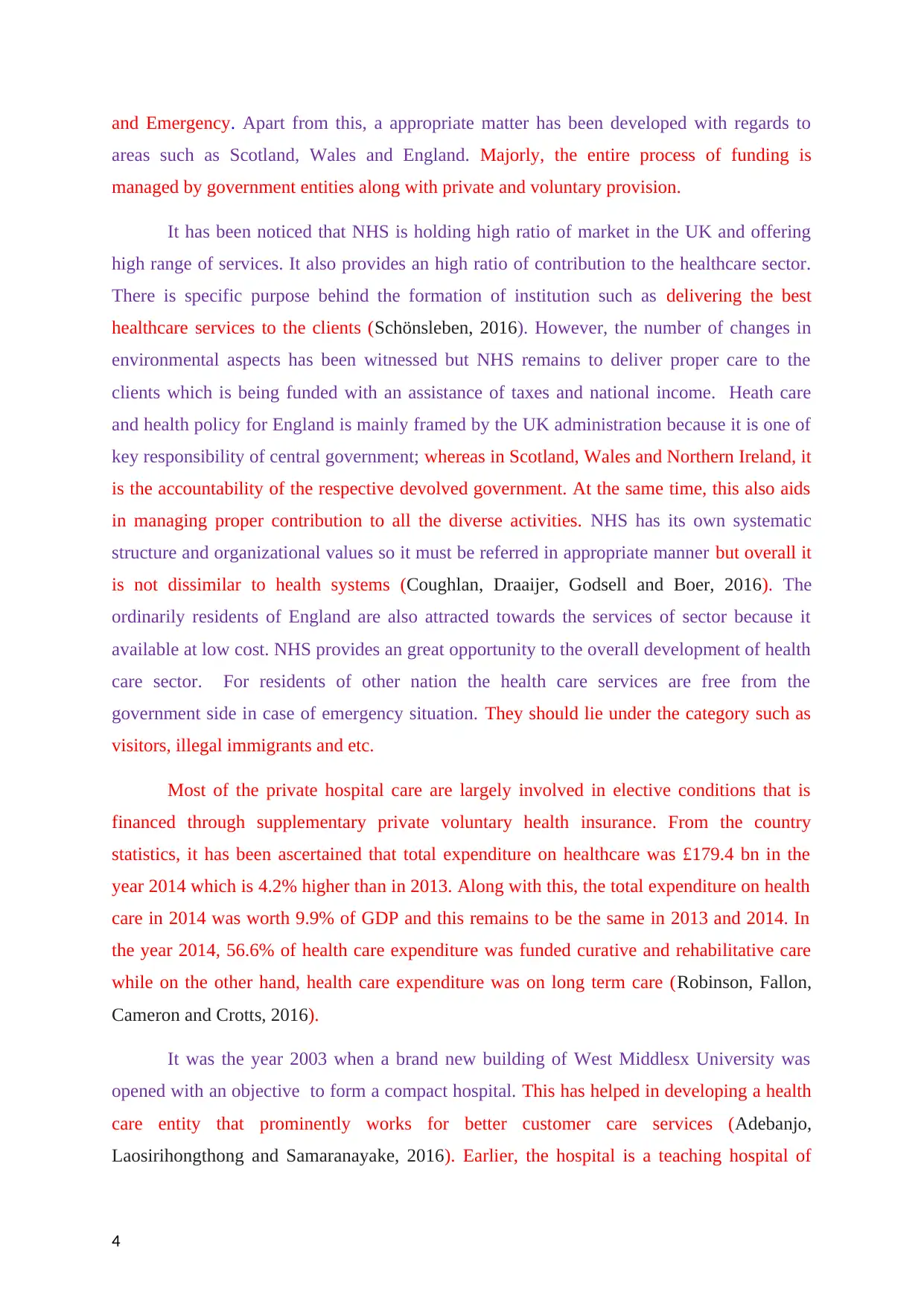
and Emergency. Apart from this, a appropriate matter has been developed with regards to
areas such as Scotland, Wales and England. Majorly, the entire process of funding is
managed by government entities along with private and voluntary provision.
It has been noticed that NHS is holding high ratio of market in the UK and offering
high range of services. It also provides an high ratio of contribution to the healthcare sector.
There is specific purpose behind the formation of institution such as delivering the best
healthcare services to the clients (Schönsleben, 2016). However, the number of changes in
environmental aspects has been witnessed but NHS remains to deliver proper care to the
clients which is being funded with an assistance of taxes and national income. Heath care
and health policy for England is mainly framed by the UK administration because it is one of
key responsibility of central government; whereas in Scotland, Wales and Northern Ireland, it
is the accountability of the respective devolved government. At the same time, this also aids
in managing proper contribution to all the diverse activities. NHS has its own systematic
structure and organizational values so it must be referred in appropriate manner but overall it
is not dissimilar to health systems (Coughlan, Draaijer, Godsell and Boer, 2016). The
ordinarily residents of England are also attracted towards the services of sector because it
available at low cost. NHS provides an great opportunity to the overall development of health
care sector. For residents of other nation the health care services are free from the
government side in case of emergency situation. They should lie under the category such as
visitors, illegal immigrants and etc.
Most of the private hospital care are largely involved in elective conditions that is
financed through supplementary private voluntary health insurance. From the country
statistics, it has been ascertained that total expenditure on healthcare was £179.4 bn in the
year 2014 which is 4.2% higher than in 2013. Along with this, the total expenditure on health
care in 2014 was worth 9.9% of GDP and this remains to be the same in 2013 and 2014. In
the year 2014, 56.6% of health care expenditure was funded curative and rehabilitative care
while on the other hand, health care expenditure was on long term care (Robinson, Fallon,
Cameron and Crotts, 2016).
It was the year 2003 when a brand new building of West Middlesx University was
opened with an objective to form a compact hospital. This has helped in developing a health
care entity that prominently works for better customer care services (Adebanjo,
Laosirihongthong and Samaranayake, 2016). Earlier, the hospital is a teaching hospital of
4
areas such as Scotland, Wales and England. Majorly, the entire process of funding is
managed by government entities along with private and voluntary provision.
It has been noticed that NHS is holding high ratio of market in the UK and offering
high range of services. It also provides an high ratio of contribution to the healthcare sector.
There is specific purpose behind the formation of institution such as delivering the best
healthcare services to the clients (Schönsleben, 2016). However, the number of changes in
environmental aspects has been witnessed but NHS remains to deliver proper care to the
clients which is being funded with an assistance of taxes and national income. Heath care
and health policy for England is mainly framed by the UK administration because it is one of
key responsibility of central government; whereas in Scotland, Wales and Northern Ireland, it
is the accountability of the respective devolved government. At the same time, this also aids
in managing proper contribution to all the diverse activities. NHS has its own systematic
structure and organizational values so it must be referred in appropriate manner but overall it
is not dissimilar to health systems (Coughlan, Draaijer, Godsell and Boer, 2016). The
ordinarily residents of England are also attracted towards the services of sector because it
available at low cost. NHS provides an great opportunity to the overall development of health
care sector. For residents of other nation the health care services are free from the
government side in case of emergency situation. They should lie under the category such as
visitors, illegal immigrants and etc.
Most of the private hospital care are largely involved in elective conditions that is
financed through supplementary private voluntary health insurance. From the country
statistics, it has been ascertained that total expenditure on healthcare was £179.4 bn in the
year 2014 which is 4.2% higher than in 2013. Along with this, the total expenditure on health
care in 2014 was worth 9.9% of GDP and this remains to be the same in 2013 and 2014. In
the year 2014, 56.6% of health care expenditure was funded curative and rehabilitative care
while on the other hand, health care expenditure was on long term care (Robinson, Fallon,
Cameron and Crotts, 2016).
It was the year 2003 when a brand new building of West Middlesx University was
opened with an objective to form a compact hospital. This has helped in developing a health
care entity that prominently works for better customer care services (Adebanjo,
Laosirihongthong and Samaranayake, 2016). Earlier, the hospital is a teaching hospital of
4
Paraphrase This Document
Need a fresh take? Get an instant paraphrase of this document with our AI Paraphraser
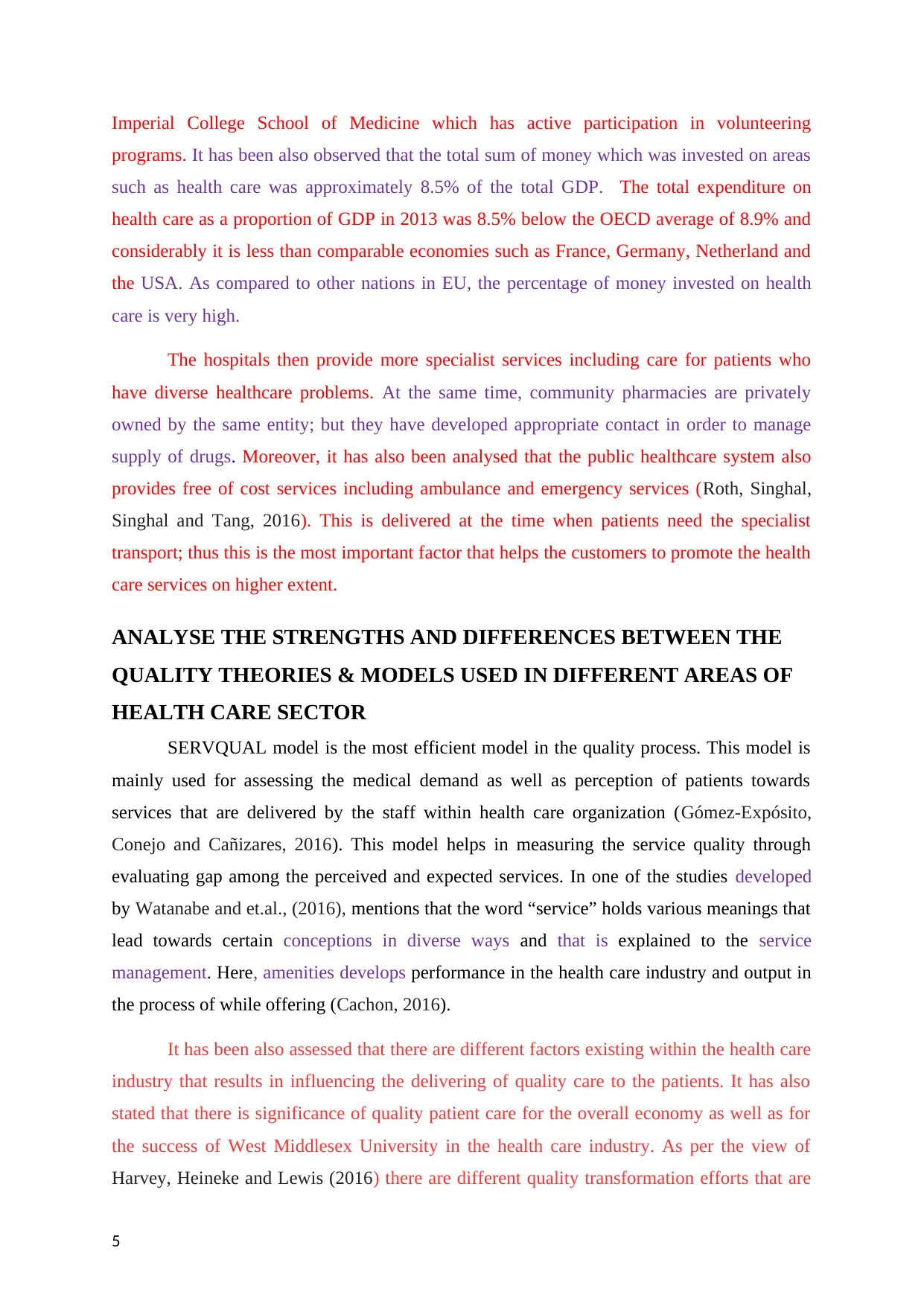
Imperial College School of Medicine which has active participation in volunteering
programs. It has been also observed that the total sum of money which was invested on areas
such as health care was approximately 8.5% of the total GDP. The total expenditure on
health care as a proportion of GDP in 2013 was 8.5% below the OECD average of 8.9% and
considerably it is less than comparable economies such as France, Germany, Netherland and
the USA. As compared to other nations in EU, the percentage of money invested on health
care is very high.
The hospitals then provide more specialist services including care for patients who
have diverse healthcare problems. At the same time, community pharmacies are privately
owned by the same entity; but they have developed appropriate contact in order to manage
supply of drugs. Moreover, it has also been analysed that the public healthcare system also
provides free of cost services including ambulance and emergency services (Roth, Singhal,
Singhal and Tang, 2016). This is delivered at the time when patients need the specialist
transport; thus this is the most important factor that helps the customers to promote the health
care services on higher extent.
ANALYSE THE STRENGTHS AND DIFFERENCES BETWEEN THE
QUALITY THEORIES & MODELS USED IN DIFFERENT AREAS OF
HEALTH CARE SECTOR
SERVQUAL model is the most efficient model in the quality process. This model is
mainly used for assessing the medical demand as well as perception of patients towards
services that are delivered by the staff within health care organization (Gómez-Expósito,
Conejo and Cañizares, 2016). This model helps in measuring the service quality through
evaluating gap among the perceived and expected services. In one of the studies developed
by Watanabe and et.al., (2016), mentions that the word “service” holds various meanings that
lead towards certain conceptions in diverse ways and that is explained to the service
management. Here, amenities develops performance in the health care industry and output in
the process of while offering (Cachon, 2016).
It has been also assessed that there are different factors existing within the health care
industry that results in influencing the delivering of quality care to the patients. It has also
stated that there is significance of quality patient care for the overall economy as well as for
the success of West Middlesex University in the health care industry. As per the view of
Harvey, Heineke and Lewis (2016) there are different quality transformation efforts that are
5
programs. It has been also observed that the total sum of money which was invested on areas
such as health care was approximately 8.5% of the total GDP. The total expenditure on
health care as a proportion of GDP in 2013 was 8.5% below the OECD average of 8.9% and
considerably it is less than comparable economies such as France, Germany, Netherland and
the USA. As compared to other nations in EU, the percentage of money invested on health
care is very high.
The hospitals then provide more specialist services including care for patients who
have diverse healthcare problems. At the same time, community pharmacies are privately
owned by the same entity; but they have developed appropriate contact in order to manage
supply of drugs. Moreover, it has also been analysed that the public healthcare system also
provides free of cost services including ambulance and emergency services (Roth, Singhal,
Singhal and Tang, 2016). This is delivered at the time when patients need the specialist
transport; thus this is the most important factor that helps the customers to promote the health
care services on higher extent.
ANALYSE THE STRENGTHS AND DIFFERENCES BETWEEN THE
QUALITY THEORIES & MODELS USED IN DIFFERENT AREAS OF
HEALTH CARE SECTOR
SERVQUAL model is the most efficient model in the quality process. This model is
mainly used for assessing the medical demand as well as perception of patients towards
services that are delivered by the staff within health care organization (Gómez-Expósito,
Conejo and Cañizares, 2016). This model helps in measuring the service quality through
evaluating gap among the perceived and expected services. In one of the studies developed
by Watanabe and et.al., (2016), mentions that the word “service” holds various meanings that
lead towards certain conceptions in diverse ways and that is explained to the service
management. Here, amenities develops performance in the health care industry and output in
the process of while offering (Cachon, 2016).
It has been also assessed that there are different factors existing within the health care
industry that results in influencing the delivering of quality care to the patients. It has also
stated that there is significance of quality patient care for the overall economy as well as for
the success of West Middlesex University in the health care industry. As per the view of
Harvey, Heineke and Lewis (2016) there are different quality transformation efforts that are
5
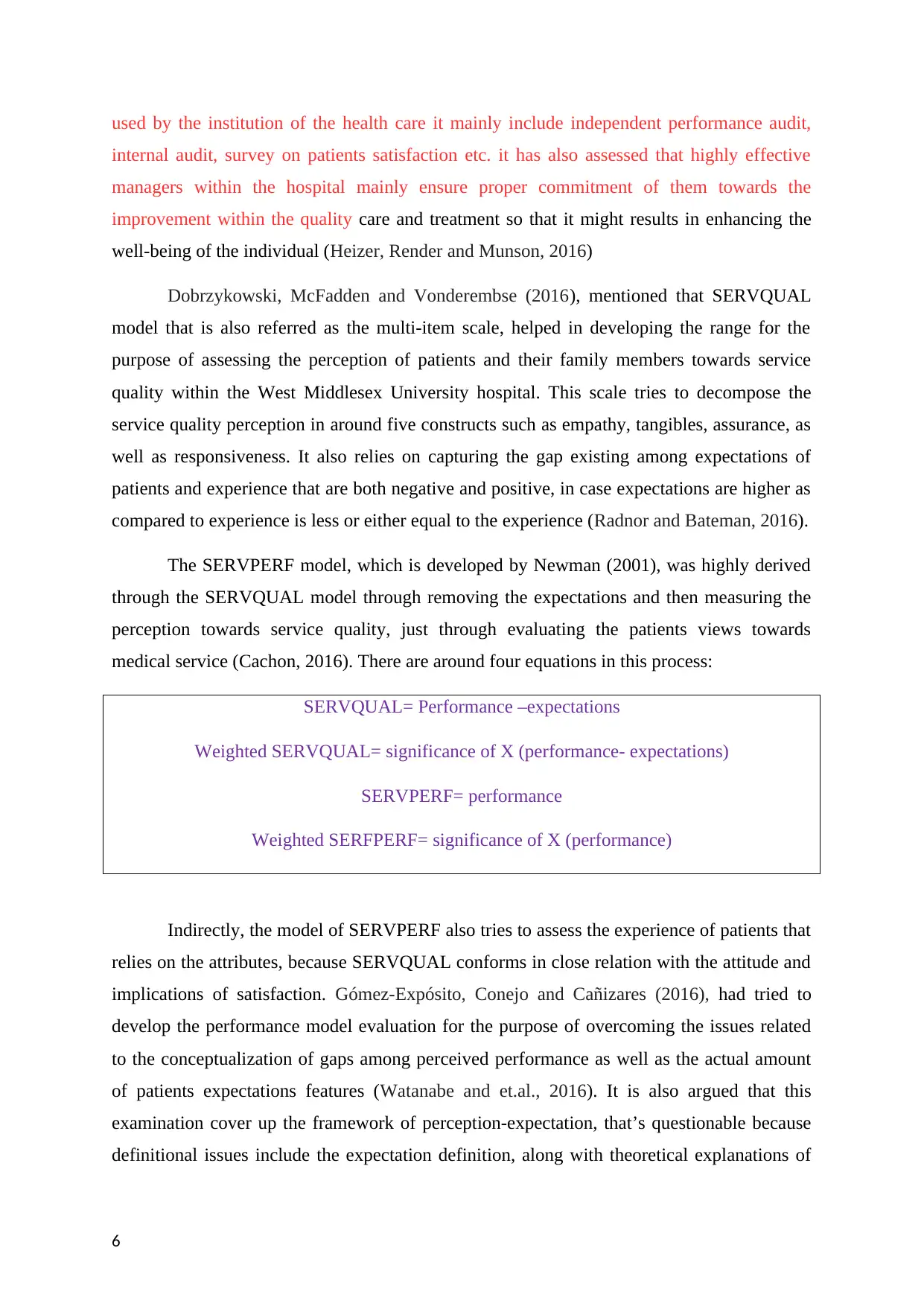
used by the institution of the health care it mainly include independent performance audit,
internal audit, survey on patients satisfaction etc. it has also assessed that highly effective
managers within the hospital mainly ensure proper commitment of them towards the
improvement within the quality care and treatment so that it might results in enhancing the
well-being of the individual (Heizer, Render and Munson, 2016)
Dobrzykowski, McFadden and Vonderembse (2016), mentioned that SERVQUAL
model that is also referred as the multi-item scale, helped in developing the range for the
purpose of assessing the perception of patients and their family members towards service
quality within the West Middlesex University hospital. This scale tries to decompose the
service quality perception in around five constructs such as empathy, tangibles, assurance, as
well as responsiveness. It also relies on capturing the gap existing among expectations of
patients and experience that are both negative and positive, in case expectations are higher as
compared to experience is less or either equal to the experience (Radnor and Bateman, 2016).
The SERVPERF model, which is developed by Newman (2001), was highly derived
through the SERVQUAL model through removing the expectations and then measuring the
perception towards service quality, just through evaluating the patients views towards
medical service (Cachon, 2016). There are around four equations in this process:
SERVQUAL= Performance –expectations
Weighted SERVQUAL= significance of X (performance- expectations)
SERVPERF= performance
Weighted SERFPERF= significance of X (performance)
Indirectly, the model of SERVPERF also tries to assess the experience of patients that
relies on the attributes, because SERVQUAL conforms in close relation with the attitude and
implications of satisfaction. Gómez-Expósito, Conejo and Cañizares (2016), had tried to
develop the performance model evaluation for the purpose of overcoming the issues related
to the conceptualization of gaps among perceived performance as well as the actual amount
of patients expectations features (Watanabe and et.al., 2016). It is also argued that this
examination cover up the framework of perception-expectation, that’s questionable because
definitional issues include the expectation definition, along with theoretical explanations of
6
internal audit, survey on patients satisfaction etc. it has also assessed that highly effective
managers within the hospital mainly ensure proper commitment of them towards the
improvement within the quality care and treatment so that it might results in enhancing the
well-being of the individual (Heizer, Render and Munson, 2016)
Dobrzykowski, McFadden and Vonderembse (2016), mentioned that SERVQUAL
model that is also referred as the multi-item scale, helped in developing the range for the
purpose of assessing the perception of patients and their family members towards service
quality within the West Middlesex University hospital. This scale tries to decompose the
service quality perception in around five constructs such as empathy, tangibles, assurance, as
well as responsiveness. It also relies on capturing the gap existing among expectations of
patients and experience that are both negative and positive, in case expectations are higher as
compared to experience is less or either equal to the experience (Radnor and Bateman, 2016).
The SERVPERF model, which is developed by Newman (2001), was highly derived
through the SERVQUAL model through removing the expectations and then measuring the
perception towards service quality, just through evaluating the patients views towards
medical service (Cachon, 2016). There are around four equations in this process:
SERVQUAL= Performance –expectations
Weighted SERVQUAL= significance of X (performance- expectations)
SERVPERF= performance
Weighted SERFPERF= significance of X (performance)
Indirectly, the model of SERVPERF also tries to assess the experience of patients that
relies on the attributes, because SERVQUAL conforms in close relation with the attitude and
implications of satisfaction. Gómez-Expósito, Conejo and Cañizares (2016), had tried to
develop the performance model evaluation for the purpose of overcoming the issues related
to the conceptualization of gaps among perceived performance as well as the actual amount
of patients expectations features (Watanabe and et.al., 2016). It is also argued that this
examination cover up the framework of perception-expectation, that’s questionable because
definitional issues include the expectation definition, along with theoretical explanations of
6
⊘ This is a preview!⊘
Do you want full access?
Subscribe today to unlock all pages.

Trusted by 1+ million students worldwide
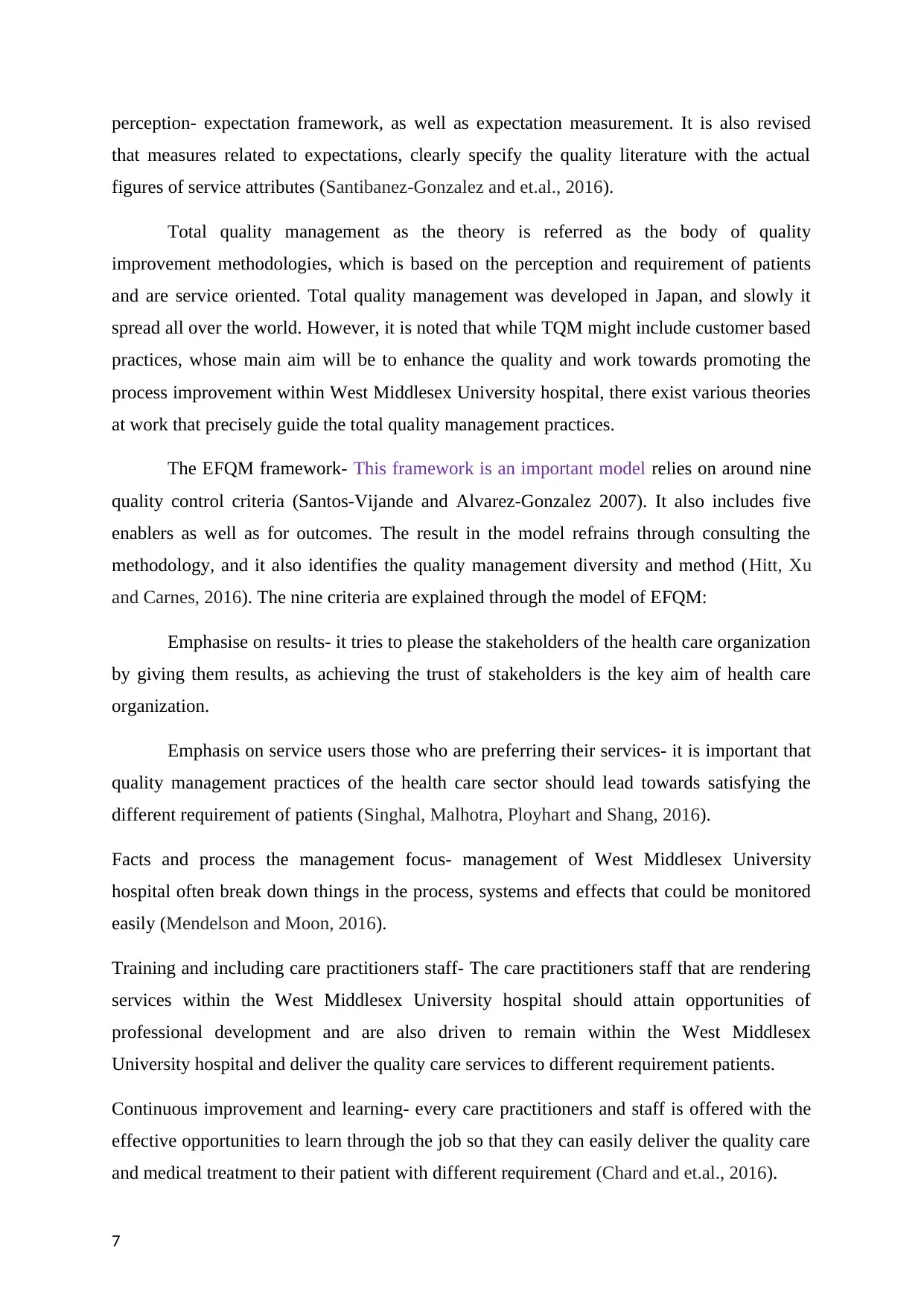
perception- expectation framework, as well as expectation measurement. It is also revised
that measures related to expectations, clearly specify the quality literature with the actual
figures of service attributes (Santibanez-Gonzalez and et.al., 2016).
Total quality management as the theory is referred as the body of quality
improvement methodologies, which is based on the perception and requirement of patients
and are service oriented. Total quality management was developed in Japan, and slowly it
spread all over the world. However, it is noted that while TQM might include customer based
practices, whose main aim will be to enhance the quality and work towards promoting the
process improvement within West Middlesex University hospital, there exist various theories
at work that precisely guide the total quality management practices.
The EFQM framework- This framework is an important model relies on around nine
quality control criteria (Santos-Vijande and Alvarez-Gonzalez 2007). It also includes five
enablers as well as for outcomes. The result in the model refrains through consulting the
methodology, and it also identifies the quality management diversity and method (Hitt, Xu
and Carnes, 2016). The nine criteria are explained through the model of EFQM:
Emphasise on results- it tries to please the stakeholders of the health care organization
by giving them results, as achieving the trust of stakeholders is the key aim of health care
organization.
Emphasis on service users those who are preferring their services- it is important that
quality management practices of the health care sector should lead towards satisfying the
different requirement of patients (Singhal, Malhotra, Ployhart and Shang, 2016).
Facts and process the management focus- management of West Middlesex University
hospital often break down things in the process, systems and effects that could be monitored
easily (Mendelson and Moon, 2016).
Training and including care practitioners staff- The care practitioners staff that are rendering
services within the West Middlesex University hospital should attain opportunities of
professional development and are also driven to remain within the West Middlesex
University hospital and deliver the quality care services to different requirement patients.
Continuous improvement and learning- every care practitioners and staff is offered with the
effective opportunities to learn through the job so that they can easily deliver the quality care
and medical treatment to their patient with different requirement (Chard and et.al., 2016).
7
that measures related to expectations, clearly specify the quality literature with the actual
figures of service attributes (Santibanez-Gonzalez and et.al., 2016).
Total quality management as the theory is referred as the body of quality
improvement methodologies, which is based on the perception and requirement of patients
and are service oriented. Total quality management was developed in Japan, and slowly it
spread all over the world. However, it is noted that while TQM might include customer based
practices, whose main aim will be to enhance the quality and work towards promoting the
process improvement within West Middlesex University hospital, there exist various theories
at work that precisely guide the total quality management practices.
The EFQM framework- This framework is an important model relies on around nine
quality control criteria (Santos-Vijande and Alvarez-Gonzalez 2007). It also includes five
enablers as well as for outcomes. The result in the model refrains through consulting the
methodology, and it also identifies the quality management diversity and method (Hitt, Xu
and Carnes, 2016). The nine criteria are explained through the model of EFQM:
Emphasise on results- it tries to please the stakeholders of the health care organization
by giving them results, as achieving the trust of stakeholders is the key aim of health care
organization.
Emphasis on service users those who are preferring their services- it is important that
quality management practices of the health care sector should lead towards satisfying the
different requirement of patients (Singhal, Malhotra, Ployhart and Shang, 2016).
Facts and process the management focus- management of West Middlesex University
hospital often break down things in the process, systems and effects that could be monitored
easily (Mendelson and Moon, 2016).
Training and including care practitioners staff- The care practitioners staff that are rendering
services within the West Middlesex University hospital should attain opportunities of
professional development and are also driven to remain within the West Middlesex
University hospital and deliver the quality care services to different requirement patients.
Continuous improvement and learning- every care practitioners and staff is offered with the
effective opportunities to learn through the job so that they can easily deliver the quality care
and medical treatment to their patient with different requirement (Chard and et.al., 2016).
7
Paraphrase This Document
Need a fresh take? Get an instant paraphrase of this document with our AI Paraphraser
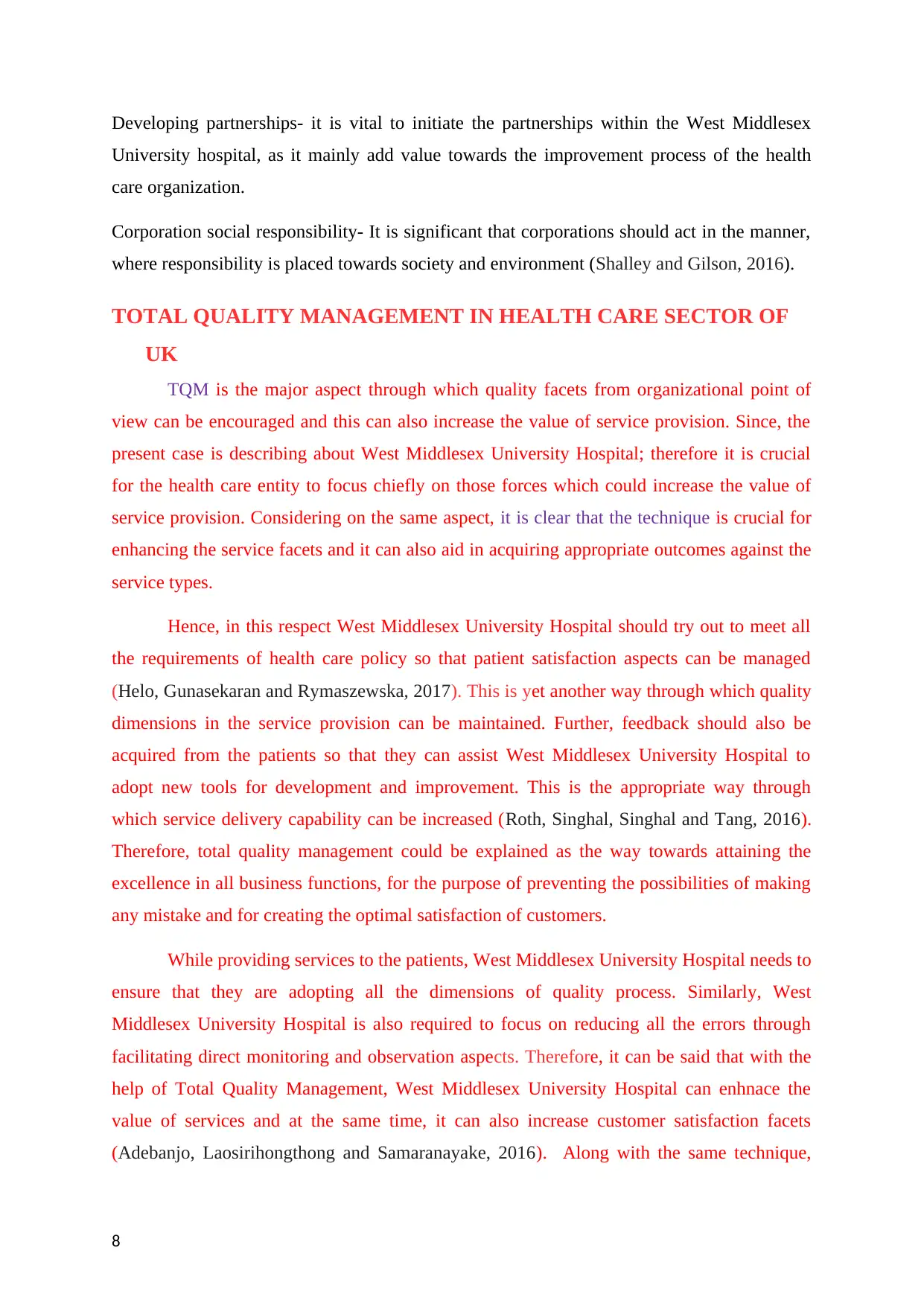
Developing partnerships- it is vital to initiate the partnerships within the West Middlesex
University hospital, as it mainly add value towards the improvement process of the health
care organization.
Corporation social responsibility- It is significant that corporations should act in the manner,
where responsibility is placed towards society and environment (Shalley and Gilson, 2016).
TOTAL QUALITY MANAGEMENT IN HEALTH CARE SECTOR OF
UK
TQM is the major aspect through which quality facets from organizational point of
view can be encouraged and this can also increase the value of service provision. Since, the
present case is describing about West Middlesex University Hospital; therefore it is crucial
for the health care entity to focus chiefly on those forces which could increase the value of
service provision. Considering on the same aspect, it is clear that the technique is crucial for
enhancing the service facets and it can also aid in acquiring appropriate outcomes against the
service types.
Hence, in this respect West Middlesex University Hospital should try out to meet all
the requirements of health care policy so that patient satisfaction aspects can be managed
(Helo, Gunasekaran and Rymaszewska, 2017). This is yet another way through which quality
dimensions in the service provision can be maintained. Further, feedback should also be
acquired from the patients so that they can assist West Middlesex University Hospital to
adopt new tools for development and improvement. This is the appropriate way through
which service delivery capability can be increased (Roth, Singhal, Singhal and Tang, 2016).
Therefore, total quality management could be explained as the way towards attaining the
excellence in all business functions, for the purpose of preventing the possibilities of making
any mistake and for creating the optimal satisfaction of customers.
While providing services to the patients, West Middlesex University Hospital needs to
ensure that they are adopting all the dimensions of quality process. Similarly, West
Middlesex University Hospital is also required to focus on reducing all the errors through
facilitating direct monitoring and observation aspects. Therefore, it can be said that with the
help of Total Quality Management, West Middlesex University Hospital can enhnace the
value of services and at the same time, it can also increase customer satisfaction facets
(Adebanjo, Laosirihongthong and Samaranayake, 2016). Along with the same technique,
8
University hospital, as it mainly add value towards the improvement process of the health
care organization.
Corporation social responsibility- It is significant that corporations should act in the manner,
where responsibility is placed towards society and environment (Shalley and Gilson, 2016).
TOTAL QUALITY MANAGEMENT IN HEALTH CARE SECTOR OF
UK
TQM is the major aspect through which quality facets from organizational point of
view can be encouraged and this can also increase the value of service provision. Since, the
present case is describing about West Middlesex University Hospital; therefore it is crucial
for the health care entity to focus chiefly on those forces which could increase the value of
service provision. Considering on the same aspect, it is clear that the technique is crucial for
enhancing the service facets and it can also aid in acquiring appropriate outcomes against the
service types.
Hence, in this respect West Middlesex University Hospital should try out to meet all
the requirements of health care policy so that patient satisfaction aspects can be managed
(Helo, Gunasekaran and Rymaszewska, 2017). This is yet another way through which quality
dimensions in the service provision can be maintained. Further, feedback should also be
acquired from the patients so that they can assist West Middlesex University Hospital to
adopt new tools for development and improvement. This is the appropriate way through
which service delivery capability can be increased (Roth, Singhal, Singhal and Tang, 2016).
Therefore, total quality management could be explained as the way towards attaining the
excellence in all business functions, for the purpose of preventing the possibilities of making
any mistake and for creating the optimal satisfaction of customers.
While providing services to the patients, West Middlesex University Hospital needs to
ensure that they are adopting all the dimensions of quality process. Similarly, West
Middlesex University Hospital is also required to focus on reducing all the errors through
facilitating direct monitoring and observation aspects. Therefore, it can be said that with the
help of Total Quality Management, West Middlesex University Hospital can enhnace the
value of services and at the same time, it can also increase customer satisfaction facets
(Adebanjo, Laosirihongthong and Samaranayake, 2016). Along with the same technique,
8
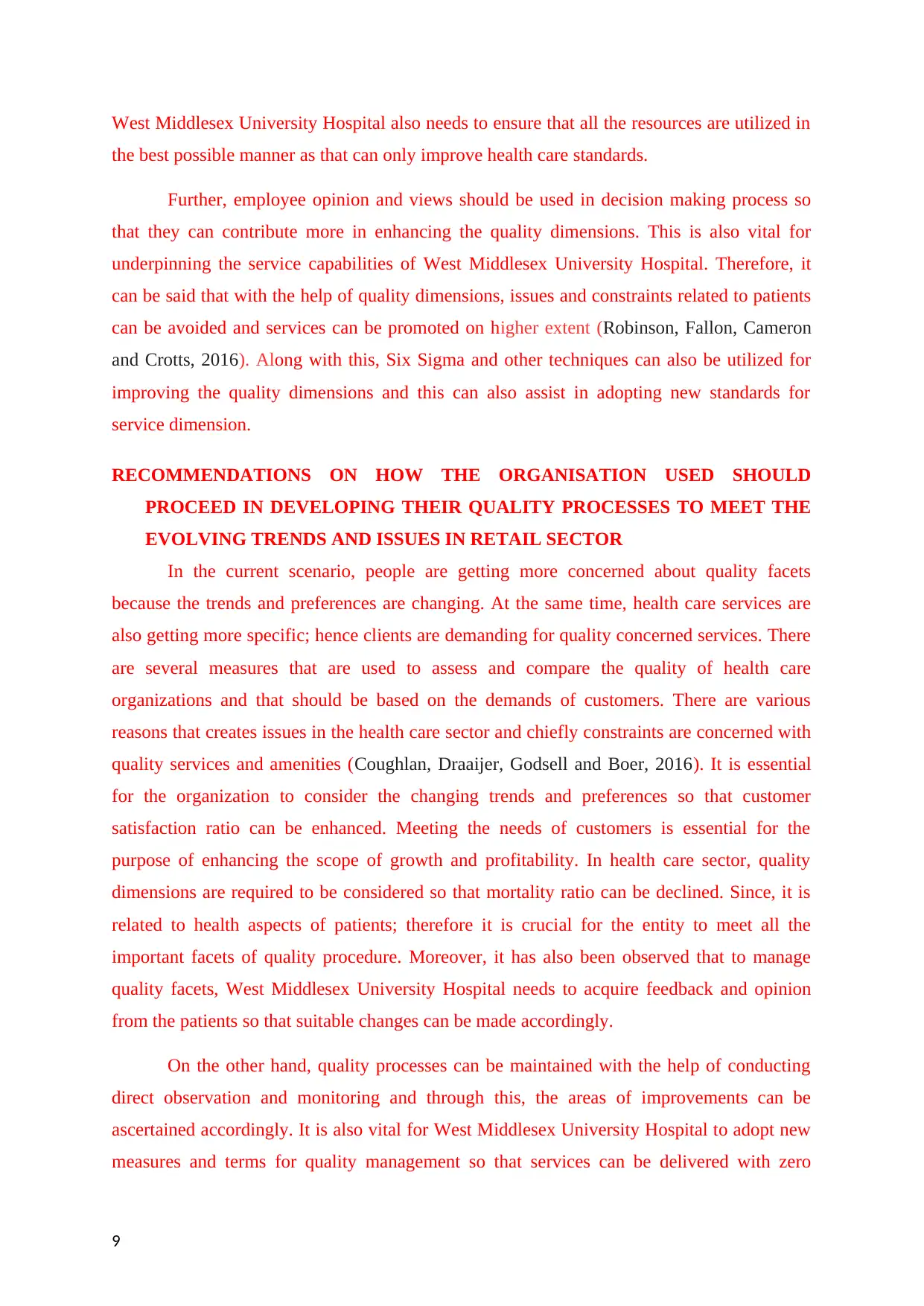
West Middlesex University Hospital also needs to ensure that all the resources are utilized in
the best possible manner as that can only improve health care standards.
Further, employee opinion and views should be used in decision making process so
that they can contribute more in enhancing the quality dimensions. This is also vital for
underpinning the service capabilities of West Middlesex University Hospital. Therefore, it
can be said that with the help of quality dimensions, issues and constraints related to patients
can be avoided and services can be promoted on higher extent (Robinson, Fallon, Cameron
and Crotts, 2016). Along with this, Six Sigma and other techniques can also be utilized for
improving the quality dimensions and this can also assist in adopting new standards for
service dimension.
RECOMMENDATIONS ON HOW THE ORGANISATION USED SHOULD
PROCEED IN DEVELOPING THEIR QUALITY PROCESSES TO MEET THE
EVOLVING TRENDS AND ISSUES IN RETAIL SECTOR
In the current scenario, people are getting more concerned about quality facets
because the trends and preferences are changing. At the same time, health care services are
also getting more specific; hence clients are demanding for quality concerned services. There
are several measures that are used to assess and compare the quality of health care
organizations and that should be based on the demands of customers. There are various
reasons that creates issues in the health care sector and chiefly constraints are concerned with
quality services and amenities (Coughlan, Draaijer, Godsell and Boer, 2016). It is essential
for the organization to consider the changing trends and preferences so that customer
satisfaction ratio can be enhanced. Meeting the needs of customers is essential for the
purpose of enhancing the scope of growth and profitability. In health care sector, quality
dimensions are required to be considered so that mortality ratio can be declined. Since, it is
related to health aspects of patients; therefore it is crucial for the entity to meet all the
important facets of quality procedure. Moreover, it has also been observed that to manage
quality facets, West Middlesex University Hospital needs to acquire feedback and opinion
from the patients so that suitable changes can be made accordingly.
On the other hand, quality processes can be maintained with the help of conducting
direct observation and monitoring and through this, the areas of improvements can be
ascertained accordingly. It is also vital for West Middlesex University Hospital to adopt new
measures and terms for quality management so that services can be delivered with zero
9
the best possible manner as that can only improve health care standards.
Further, employee opinion and views should be used in decision making process so
that they can contribute more in enhancing the quality dimensions. This is also vital for
underpinning the service capabilities of West Middlesex University Hospital. Therefore, it
can be said that with the help of quality dimensions, issues and constraints related to patients
can be avoided and services can be promoted on higher extent (Robinson, Fallon, Cameron
and Crotts, 2016). Along with this, Six Sigma and other techniques can also be utilized for
improving the quality dimensions and this can also assist in adopting new standards for
service dimension.
RECOMMENDATIONS ON HOW THE ORGANISATION USED SHOULD
PROCEED IN DEVELOPING THEIR QUALITY PROCESSES TO MEET THE
EVOLVING TRENDS AND ISSUES IN RETAIL SECTOR
In the current scenario, people are getting more concerned about quality facets
because the trends and preferences are changing. At the same time, health care services are
also getting more specific; hence clients are demanding for quality concerned services. There
are several measures that are used to assess and compare the quality of health care
organizations and that should be based on the demands of customers. There are various
reasons that creates issues in the health care sector and chiefly constraints are concerned with
quality services and amenities (Coughlan, Draaijer, Godsell and Boer, 2016). It is essential
for the organization to consider the changing trends and preferences so that customer
satisfaction ratio can be enhanced. Meeting the needs of customers is essential for the
purpose of enhancing the scope of growth and profitability. In health care sector, quality
dimensions are required to be considered so that mortality ratio can be declined. Since, it is
related to health aspects of patients; therefore it is crucial for the entity to meet all the
important facets of quality procedure. Moreover, it has also been observed that to manage
quality facets, West Middlesex University Hospital needs to acquire feedback and opinion
from the patients so that suitable changes can be made accordingly.
On the other hand, quality processes can be maintained with the help of conducting
direct observation and monitoring and through this, the areas of improvements can be
ascertained accordingly. It is also vital for West Middlesex University Hospital to adopt new
measures and terms for quality management so that services can be delivered with zero
9
⊘ This is a preview!⊘
Do you want full access?
Subscribe today to unlock all pages.

Trusted by 1+ million students worldwide
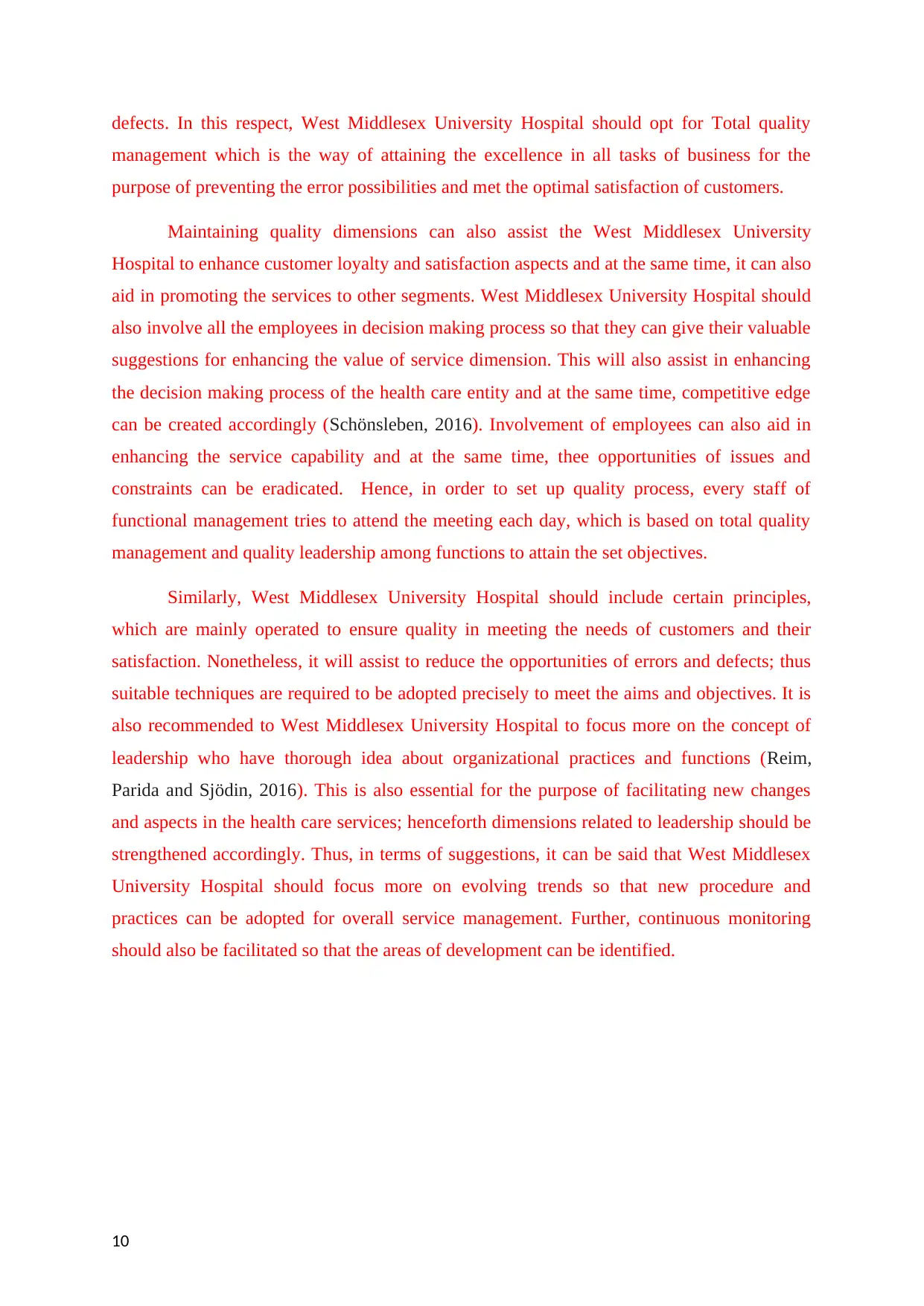
defects. In this respect, West Middlesex University Hospital should opt for Total quality
management which is the way of attaining the excellence in all tasks of business for the
purpose of preventing the error possibilities and met the optimal satisfaction of customers.
Maintaining quality dimensions can also assist the West Middlesex University
Hospital to enhance customer loyalty and satisfaction aspects and at the same time, it can also
aid in promoting the services to other segments. West Middlesex University Hospital should
also involve all the employees in decision making process so that they can give their valuable
suggestions for enhancing the value of service dimension. This will also assist in enhancing
the decision making process of the health care entity and at the same time, competitive edge
can be created accordingly (Schönsleben, 2016). Involvement of employees can also aid in
enhancing the service capability and at the same time, thee opportunities of issues and
constraints can be eradicated. Hence, in order to set up quality process, every staff of
functional management tries to attend the meeting each day, which is based on total quality
management and quality leadership among functions to attain the set objectives.
Similarly, West Middlesex University Hospital should include certain principles,
which are mainly operated to ensure quality in meeting the needs of customers and their
satisfaction. Nonetheless, it will assist to reduce the opportunities of errors and defects; thus
suitable techniques are required to be adopted precisely to meet the aims and objectives. It is
also recommended to West Middlesex University Hospital to focus more on the concept of
leadership who have thorough idea about organizational practices and functions (Reim,
Parida and Sjödin, 2016). This is also essential for the purpose of facilitating new changes
and aspects in the health care services; henceforth dimensions related to leadership should be
strengthened accordingly. Thus, in terms of suggestions, it can be said that West Middlesex
University Hospital should focus more on evolving trends so that new procedure and
practices can be adopted for overall service management. Further, continuous monitoring
should also be facilitated so that the areas of development can be identified.
10
management which is the way of attaining the excellence in all tasks of business for the
purpose of preventing the error possibilities and met the optimal satisfaction of customers.
Maintaining quality dimensions can also assist the West Middlesex University
Hospital to enhance customer loyalty and satisfaction aspects and at the same time, it can also
aid in promoting the services to other segments. West Middlesex University Hospital should
also involve all the employees in decision making process so that they can give their valuable
suggestions for enhancing the value of service dimension. This will also assist in enhancing
the decision making process of the health care entity and at the same time, competitive edge
can be created accordingly (Schönsleben, 2016). Involvement of employees can also aid in
enhancing the service capability and at the same time, thee opportunities of issues and
constraints can be eradicated. Hence, in order to set up quality process, every staff of
functional management tries to attend the meeting each day, which is based on total quality
management and quality leadership among functions to attain the set objectives.
Similarly, West Middlesex University Hospital should include certain principles,
which are mainly operated to ensure quality in meeting the needs of customers and their
satisfaction. Nonetheless, it will assist to reduce the opportunities of errors and defects; thus
suitable techniques are required to be adopted precisely to meet the aims and objectives. It is
also recommended to West Middlesex University Hospital to focus more on the concept of
leadership who have thorough idea about organizational practices and functions (Reim,
Parida and Sjödin, 2016). This is also essential for the purpose of facilitating new changes
and aspects in the health care services; henceforth dimensions related to leadership should be
strengthened accordingly. Thus, in terms of suggestions, it can be said that West Middlesex
University Hospital should focus more on evolving trends so that new procedure and
practices can be adopted for overall service management. Further, continuous monitoring
should also be facilitated so that the areas of development can be identified.
10
Paraphrase This Document
Need a fresh take? Get an instant paraphrase of this document with our AI Paraphraser

References
Adebanjo, D., Laosirihongthong, T. and Samaranayake, P., 2016. Prioritizing lean supply
chain management initiatives in healthcare service operations: a fuzzy AHP
approach. Production Planning & Control. pp.1-14.
Cachon, G., 2016. Operations Management, 1e. McGraw-Hill Higher Education.
Chard, K. and et.al., 2016. Globus Nexus: A Platform-as-a-Service provider of research
identity, profile, and group management. Future Generation Computer Systems. 56.
pp.571-583.
Coughlan, P., Draaijer, D., Godsell, J. and Boer, H., 2016. Operations and supply chain
management-the role of academics and practitioners in the development of research
and practice. International Journal of Operations and Production Management.
Dobrzykowski, D.D., McFadden, K.L. and Vonderembse, M.A., 2016. Examining pathways
to safety and financial performance in hospitals: A study of lean in professional
service operations. Journal of Operations Management. 42. pp.39-51.
Gómez-Expósito, A., Conejo, A.J. and Cañizares, C., 2016. Electric energy systems: analysis
and operation. CRC Press.
Harvey, J., Heineke, J. and Lewis, M., 2016. Editorial for Journal of Operations Management
special issue on" Professional Service Operations Management (PSOM)". Journal of
Operations Management. 42. pp.4-8.
Heizer, J., Render, B. and Munson, C., 2016. Principles of operations management:
sustainability and supply chain management. Pearson Higher Ed.
Helo, P., Gunasekaran, A. and Rymaszewska, A., 2017. Improving Marketing and Operations
Strategy Through Industrial Services. In Designing and Managing Industrial Product-
Service Systems (pp. 37-42). Springer International Publishing.
Hitt, M.A., Xu, K. and Carnes, C.M., 2016. Resource based theory in operations management
research. Journal of Operations Management. 41. pp.77-94.
Mendelson, H. and Moon, K., 2016. Modeling Growth in Service Operations: Evidence from
the App Economy. Available at SSRN 2777764.
11
Adebanjo, D., Laosirihongthong, T. and Samaranayake, P., 2016. Prioritizing lean supply
chain management initiatives in healthcare service operations: a fuzzy AHP
approach. Production Planning & Control. pp.1-14.
Cachon, G., 2016. Operations Management, 1e. McGraw-Hill Higher Education.
Chard, K. and et.al., 2016. Globus Nexus: A Platform-as-a-Service provider of research
identity, profile, and group management. Future Generation Computer Systems. 56.
pp.571-583.
Coughlan, P., Draaijer, D., Godsell, J. and Boer, H., 2016. Operations and supply chain
management-the role of academics and practitioners in the development of research
and practice. International Journal of Operations and Production Management.
Dobrzykowski, D.D., McFadden, K.L. and Vonderembse, M.A., 2016. Examining pathways
to safety and financial performance in hospitals: A study of lean in professional
service operations. Journal of Operations Management. 42. pp.39-51.
Gómez-Expósito, A., Conejo, A.J. and Cañizares, C., 2016. Electric energy systems: analysis
and operation. CRC Press.
Harvey, J., Heineke, J. and Lewis, M., 2016. Editorial for Journal of Operations Management
special issue on" Professional Service Operations Management (PSOM)". Journal of
Operations Management. 42. pp.4-8.
Heizer, J., Render, B. and Munson, C., 2016. Principles of operations management:
sustainability and supply chain management. Pearson Higher Ed.
Helo, P., Gunasekaran, A. and Rymaszewska, A., 2017. Improving Marketing and Operations
Strategy Through Industrial Services. In Designing and Managing Industrial Product-
Service Systems (pp. 37-42). Springer International Publishing.
Hitt, M.A., Xu, K. and Carnes, C.M., 2016. Resource based theory in operations management
research. Journal of Operations Management. 41. pp.77-94.
Mendelson, H. and Moon, K., 2016. Modeling Growth in Service Operations: Evidence from
the App Economy. Available at SSRN 2777764.
11
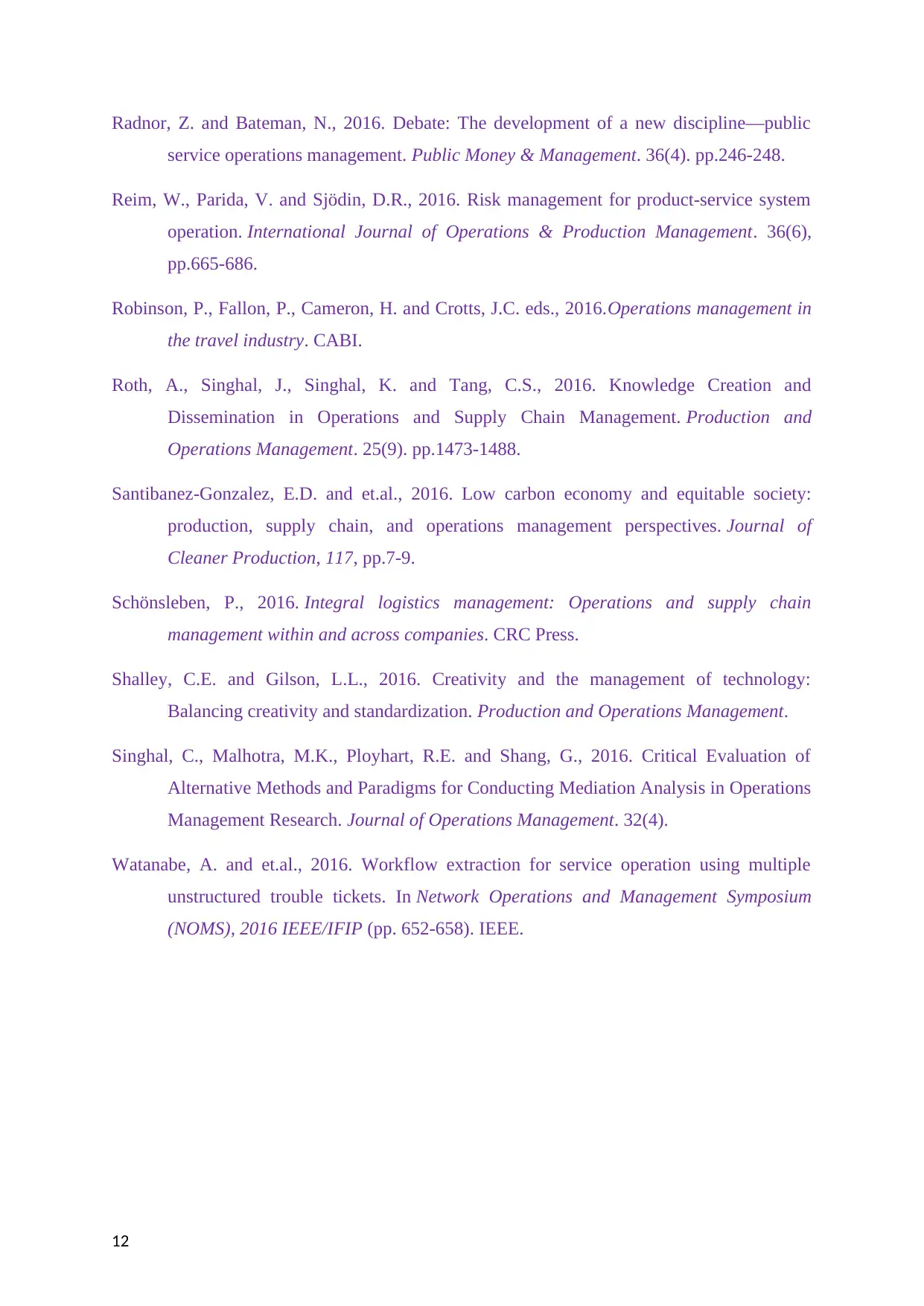
Radnor, Z. and Bateman, N., 2016. Debate: The development of a new discipline—public
service operations management. Public Money & Management. 36(4). pp.246-248.
Reim, W., Parida, V. and Sjödin, D.R., 2016. Risk management for product-service system
operation. International Journal of Operations & Production Management. 36(6),
pp.665-686.
Robinson, P., Fallon, P., Cameron, H. and Crotts, J.C. eds., 2016.Operations management in
the travel industry. CABI.
Roth, A., Singhal, J., Singhal, K. and Tang, C.S., 2016. Knowledge Creation and
Dissemination in Operations and Supply Chain Management. Production and
Operations Management. 25(9). pp.1473-1488.
Santibanez-Gonzalez, E.D. and et.al., 2016. Low carbon economy and equitable society:
production, supply chain, and operations management perspectives. Journal of
Cleaner Production, 117, pp.7-9.
Schönsleben, P., 2016. Integral logistics management: Operations and supply chain
management within and across companies. CRC Press.
Shalley, C.E. and Gilson, L.L., 2016. Creativity and the management of technology:
Balancing creativity and standardization. Production and Operations Management.
Singhal, C., Malhotra, M.K., Ployhart, R.E. and Shang, G., 2016. Critical Evaluation of
Alternative Methods and Paradigms for Conducting Mediation Analysis in Operations
Management Research. Journal of Operations Management. 32(4).
Watanabe, A. and et.al., 2016. Workflow extraction for service operation using multiple
unstructured trouble tickets. In Network Operations and Management Symposium
(NOMS), 2016 IEEE/IFIP (pp. 652-658). IEEE.
12
service operations management. Public Money & Management. 36(4). pp.246-248.
Reim, W., Parida, V. and Sjödin, D.R., 2016. Risk management for product-service system
operation. International Journal of Operations & Production Management. 36(6),
pp.665-686.
Robinson, P., Fallon, P., Cameron, H. and Crotts, J.C. eds., 2016.Operations management in
the travel industry. CABI.
Roth, A., Singhal, J., Singhal, K. and Tang, C.S., 2016. Knowledge Creation and
Dissemination in Operations and Supply Chain Management. Production and
Operations Management. 25(9). pp.1473-1488.
Santibanez-Gonzalez, E.D. and et.al., 2016. Low carbon economy and equitable society:
production, supply chain, and operations management perspectives. Journal of
Cleaner Production, 117, pp.7-9.
Schönsleben, P., 2016. Integral logistics management: Operations and supply chain
management within and across companies. CRC Press.
Shalley, C.E. and Gilson, L.L., 2016. Creativity and the management of technology:
Balancing creativity and standardization. Production and Operations Management.
Singhal, C., Malhotra, M.K., Ployhart, R.E. and Shang, G., 2016. Critical Evaluation of
Alternative Methods and Paradigms for Conducting Mediation Analysis in Operations
Management Research. Journal of Operations Management. 32(4).
Watanabe, A. and et.al., 2016. Workflow extraction for service operation using multiple
unstructured trouble tickets. In Network Operations and Management Symposium
(NOMS), 2016 IEEE/IFIP (pp. 652-658). IEEE.
12
⊘ This is a preview!⊘
Do you want full access?
Subscribe today to unlock all pages.

Trusted by 1+ million students worldwide
1 out of 12
Related Documents
Your All-in-One AI-Powered Toolkit for Academic Success.
+13062052269
info@desklib.com
Available 24*7 on WhatsApp / Email
![[object Object]](/_next/static/media/star-bottom.7253800d.svg)
Unlock your academic potential
Copyright © 2020–2025 A2Z Services. All Rights Reserved. Developed and managed by ZUCOL.





